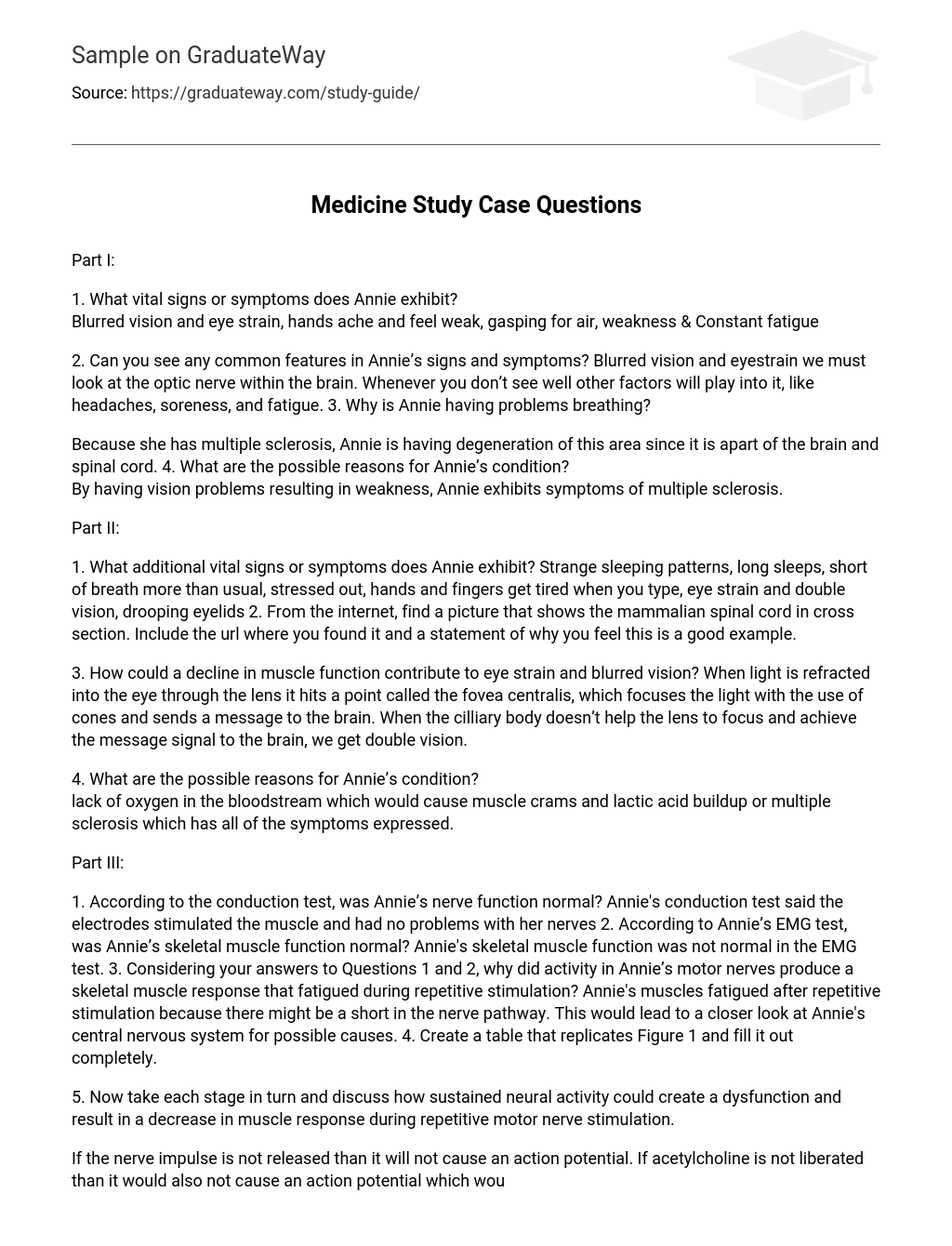Part I:
1. What vital signs or symptoms does Annie exhibit?
Blurred vision and eye strain, hands ache and feel weak, gasping for air, weakness & Constant fatigue
2. Can you see any common features in Annie’s signs and symptoms? Blurred vision and eyestrain we must look at the optic nerve within the brain. Whenever you don’t see well other factors will play into it, like headaches, soreness, and fatigue. 3. Why is Annie having problems breathing?
Because she has multiple sclerosis, Annie is having degeneration of this area since it is apart of the brain and spinal cord. 4. What are the possible reasons for Annie’s condition?
By having vision problems resulting in weakness, Annie exhibits symptoms of multiple sclerosis.
Part II:
1. What additional vital signs or symptoms does Annie exhibit? Strange sleeping patterns, long sleeps, short of breath more than usual, stressed out, hands and fingers get tired when you type, eye strain and double vision, drooping eyelids 2. From the internet, find a picture that shows the mammalian spinal cord in cross section. Include the url where you found it and a statement of why you feel this is a good example.
3. How could a decline in muscle function contribute to eye strain and blurred vision? When light is refracted into the eye through the lens it hits a point called the fovea centralis, which focuses the light with the use of cones and sends a message to the brain. When the cilliary body doesn’t help the lens to focus and achieve the message signal to the brain, we get double vision.
4. What are the possible reasons for Annie’s condition?
lack of oxygen in the bloodstream which would cause muscle crams and lactic acid buildup or multiple sclerosis which has all of the symptoms expressed.
Part III:
1. According to the conduction test, was Annie’s nerve function normal? Annie’s conduction test said the electrodes stimulated the muscle and had no problems with her nerves 2. According to Annie’s EMG test, was Annie’s skeletal muscle function normal? Annie’s skeletal muscle function was not normal in the EMG test. 3. Considering your answers to Questions 1 and 2, why did activity in Annie’s motor nerves produce a skeletal muscle response that fatigued during repetitive stimulation? Annie’s muscles fatigued after repetitive stimulation because there might be a short in the nerve pathway. This would lead to a closer look at Annie’s central nervous system for possible causes. 4. Create a table that replicates Figure 1 and fill it out completely.
5. Now take each stage in turn and discuss how sustained neural activity could create a dysfunction and result in a decrease in muscle response during repetitive motor nerve stimulation.
If the nerve impulse is not released than it will not cause an action potential. If acetylcholine is not liberated than it would also not cause an action potential which would not cause a muscle contraction. If the calcium and sodium channels remain open, it would cause a uncontrolled muscle twitch.
Part IV:
1. What is the role of the thymus in the body?
It processes the white blood cells T-lymphocytes which add cells in finding and destroying bacteria, viruses, abnormal cell growth and non cell tissues.
2. What is an antigen?
An antigen is anything in the body the is non self which could include bacteria, viruses, chemicals or abnormal cell growth. 3. Go back to Figure 1, look at each stage, and predict where the antibodies in Annie’s blood could act to decrease synaptic function at the neuromuscular junction. The antibodies in the presynaptic terminal are decreasing the rate the calcium is binding and causing a decrease rate of acetylcholine to be released. 4. Neostigmine is one drug that may be prescribed for people with myasthenia gravis. This drug, like the edrophonium chloride injection, will make Annie feel stronger. Go back to the flow diagram, look at each stage, and determine how these drugs could work to increase synaptic performance. These drug increase the function of the voltage gated channels which increase the rate that the acetylcholine is released which causes a action potential and a muscle contraction. 5. In the absence of treatment, what has happened to the amplitude of Annie’s endplate potentials as her disease has progressed? Without surgery to remove the tumor on the thymus, the synaptic firing will decreases rapidly. The antigens will continue to attached the antibodies and her condition will grow worse with possible loss of muscle function and possible loss of vision.
6. Can you account for her progressive weakness?
Her progressive weakness is due to a tumor in her thymus gland
Source: National Center for Case Study Teaching in Science





